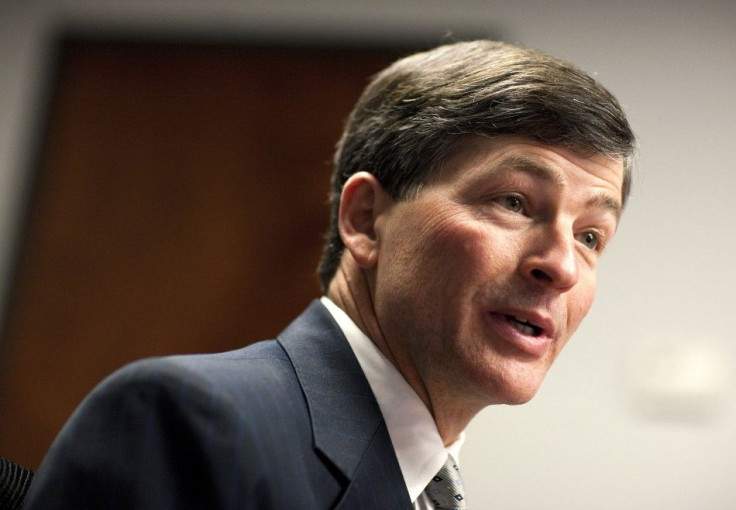Deficit Deadlock May Send New Chills Through Global Markets
ANALYSIS

A brutal year for global investors may get even worse next week should the U.S. Congress prove yet again it is too bitterly divided to deliver on its promise to cut the gaping federal budget deficit.
How financial markets will react if a committee created to slash $1.2 trillion in federal spending over 10 years fails to strike a deal is a tough call, partly because investors have been distracted by a Europe's more immediate debt crisis.
For one thing, market expectations could hardly be lower, especially with an election year looming and memories of the summer's ugly debate over raising the country's debt ceiling and the resulting loss of the nation's triple-A credit rating still fresh in investors' minds.
Also, any budget cuts wouldn't take effect until 2013 and failure would not trigger an immediate government shutdown or interrupt important services.
But a sharp, out-of-nowhere sell-off in U.S. markets on Thursday afternoon was blamed in part on vague rumors that talks to trim federal spending had stalled.
This thing is incredibly difficult to handicap, said Jacob Oubina, senior U.S. economist at RBC Capital Markets. But the last thing you want is to introduce another element of volatility into the markets, and that's exactly what these guys are going to do because they can't get their act together.
The biggest concern is not the cuts as such but the sense that Democrats and Republicans are simply unable to compromise and make the tough decisions required to bring a deficit that is near 10 percent of gross domestic product under control.
There are two diametrically opposed groups here, each against what the other side is trying to do, and both see benefit to failure because they can campaign on that, said Gregory Whiteley, who helps manage $19 billion at DoubleLine Capital in Los Angeles. So expectations are pretty low.
Clashes between Democrats and Republicans over the right mix of spending cuts and tax hikes almost scuppered a deal to lift the debt ceiling in August, raising the threat of default and spurring Standard & Poor's to cut America's credit rating.
Threat to Growth
Some investors fear that deadlock may imperil White House efforts to extend a temporary payroll tax cut and jobless benefits for the long-term unemployed, and that would be another negative for growth at a time when the economy can least afford it.
RBC economists said that if those measures, along with some investment tax credits, expire at the end of this year, it could shave 1.2 percent from U.S. growth next year.
That could roil U.S. stocks, which have been on a roller-coaster ride since August and just had their worst weekly showing in two months.
Stocks could lose 5 percent to 10 percent in the short run if anxiety about Washington policy gridlock really takes hold, said David D'Amico, president and chief strategist at Braver Capital in Boston.
If they don't come out with anything and they force cuts and it becomes a political sideshow and the public and consumers become somewhat disgusted again with Washington, you could have a real sell-off in the marketplace, D'Amico said.
Low Expectations
While not expected, a deal to cut the full $1.2 trillion would probably provoke a relief rally in markets, investors said.
Marc Doss, regional chief investment officer at the Wells Fargo Private Bank in San Diego, said that could be a green light for hedge funds and other money managers who are underinvested in stocks because of recent market turmoil to kick off a year-end rally.
Expectations are low after the debt-ceiling debacle, but if they get to $1.2 trillion, it would instill some confidence in the political process, he said.
Bond investors say deadlock probably won't hurt the bond market, either, since Europe's problems should sustain a safe-haven bid for Treasuries.
Jack McIntyre, who helps manage a global fixed income portfolio at Philadelphia-based Brandywine Global, said that's why he remains overweight the dollar relative to the euro even as he favors currencies from faster-growing emerging markets over the greenback.
The 10-year Treasury note was yielding 2.01 percent on Friday. Among major developed markets, that was above comparable yields only in Germany and Japan.
And if stocks do wobble, another round of monetary easing from the Federal Reserve, which has toyed with the idea of pumping more money into the system by doing additional purchases of mortgage-backed debt, could help support asset prices.
Long-Run Risks
In the long run, though, the parallels with Europe's most troubled countries become more striking and harder to ignore.
Harm Bandholz, chief U.S. economist at UniCredit, said America is treading a path similar to the one that led Greece, Italy, and others into trouble: borrowing money at low interest rates to boost short-term growth and swelling the debt burden.
As governments in Rome, Madrid, and elsewhere found out in recent days when their borrowing costs spiked to euro-era highs, that can only go on for so long. The U.S. is still running at full speed in the wrong direction, Bandholz said.
Additionally, about 71 percent of marketable U.S. debt will mature in the next five years, said Lawrence Goodman, president of the Center for Financial Stability in New York. That's well above the historical average and makes the country vulnerable to refinancing risk.
Markets continue to give the U.S. a pass on its excessive deficit, he said. But what's happening in Europe should be a powerful lesson, especially given our maturity profile.
(Additional reporting by Sam Forgione in New York and Stella Dawson in Washington. Editing by Martin Howell)
© Copyright Thomson Reuters 2024. All rights reserved.





















